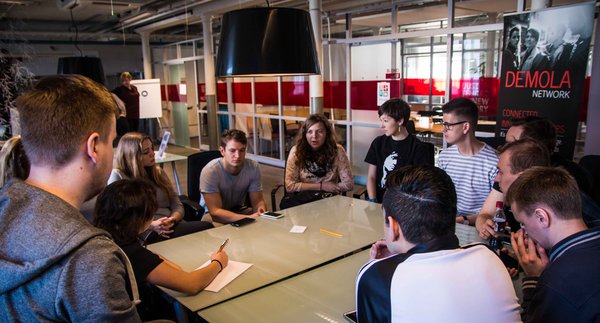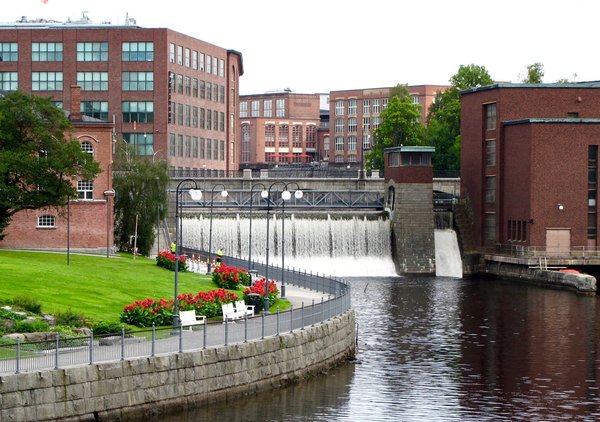Demola – how did it actually come about?
8.8.2016The idea, the right people, enthusiastic supporters and the right timing – these were the factors behind Demola, thanks to which Tampere is now globally known as a city of innovation. Tampere – All Bright! Magazine delves more deeply into the story.

How could the unspoiled brains of students be harnessed for innovation use? This was the leading question when Jukka P. Saarinen of the Nokia Research Center started sketching the first presentation of a demo factory to be established for students in Tampere. It was January 2008, and Saarinen had been involved in establishing Nokia Innovation Center in Tampere in the previous year, contributing to a more open research culture between Nokia and the researchers at Tampere University of Technology (TUT).
“We then started thinking about how there were 30,000 students in the region! Students are a window to the future. When you give them a topic to handle, they are likely to come up with something that might interest consumers in the coming years,” Saarinen says.
It is no wonder that there was now an interest in students’ brains. From the outset, the key idea behind Demola was that the co-operation must be fair and reasonable for the students. Accordingly, Demola’s IPR model was prepared such that the students own the rights to their project output and the company can gain a licence to the results by paying a licensing fee to the students.
“In the Demola model, the students are the creative force on whose terms we operate. This is the biggest thing which we have done right from the beginning and which has made Demola so attractive.”
Saarinen finished his presentation and went out to meet people: rectors, professors, Tampere city administration, Tekes (the Finnish Funding Agency for Innovation) people in Tampere… The new idea was received enthusiastically, so the demo factory began to take shape: what was needed were premises, contract models and funding.
“This is when Petri Räsänen became involved and I also met Ville Kairamo for the first time. Both have played a key role in the development of Demola,” Saarinen says.
“Initially, our working title for the project was ‘Grease Pit’. This reflects our common endeavour to become practically and flexibly involved with innovation instead of sinking into a mire of preparatory meetings, extended projects and heavy reporting,” Räsänen says.
“Yes, people told us that we were crazy and it would never work. But it did – in small steps, through doing things together with our partners and teams,” Kairamo notes.

The premises were found in the former Finlayson factory, help on the contracts was received from Nokia’s lawyers and Hermia Group, and some of the initial funding was provided by the City of Tampere and the Centre for Economic Development, Transport and the Environment (ELY Centre). Saarinen compiled a number of topics mainly from Nokia for use by the students in the first Demola period.
“We started with small resources but believed in the idea. In the first year, we put out a lot of fires – we had to try and solve all the questions we faced on the fly. And we did solve them,” Saarinen says.
The results of the first Demola projects were presented in early 2009, and when a new round was started, several companies became involved. The key pieces of Demola were put in the right places in the course of that year.
“We also saw an interesting phenomenon: many students who had taken part in Demola projects also wanted to come and help in facilitating new projects,” Saarinen says.
Fine-tuning the Demola model took another two or three years, and the innovation and product development centre New Factory was gradually created around it. Saarinen moved from developing Demola to using it, and the finalisation of the innovation process was led by Räsänen and Kairamo. The work was based on continuous internal assessment and listening closely to clients, which has been the most important prerequisite for success according to Räsänen.
“We collected and listened to feedback from the students and companies involved in the projects. Based on the feedback, we revamped the operations, tried new things and assessed the results again. Each period was carried out slightly differently from the one before it.”
Continuous evolution is also part of the Demola idea. Räsänen thinks that Demola Tampere can take the next natural step with Tampere3, the merger of the local universities.
“One direction would be to make Demola available to an increasing number of Tampere3 students, so that it would also better serve Tampere3 research activities,” Räsänen says.

Demola’s internationalisation has been a natural process. Many of the students who participate in the projects are foreign, and the new learning experiences they receive can easily turn them into ambassadors for Demola.
“After returning to their home countries, a number of students have asked their own universities when similar activities could be started there as well,” Saarinen says.
“People who have set out into the world from Demola Tampere have started their careers, many of them in good positions, and can do interesting things together and separately. In this sense, these activities may have surprisingly major effects in the long term,” Räsänen says.
The world has also been happy to come to Demola. It has been visited by international groups, including university representatives and city developers, who have learnt about how students in Tampere can do real work during their studies in interaction with the industry. Demola soon started receiving contacts from abroad so frequently that investing into international operations became a point of discussion.
“We came to the conclusion that when we form partnerships with interesting actors, 1+1 equals 3,” says Kairamo, who is taking the operations abroad as the head of the international Demola Network.

Demola locations have been established in various corners of the world: in early 2016, the latest addresses were in Namibia and South Africa. (For the latest expansion news, go to: http://www.demola.net/news) According to Kairamo, a turn in the internationalisation was seen in 2015, when major global companies truly started realising that Demola is not just a local phenomenon but rather a large, ever-expanding organisation.
“We have set ourselves the practical goal of having a total of 5,000 innovation projects carried out annually at various Demola locations across the globe by 2020,” Kairamo says.
Having started with just a handful of projects in 2008, Demola is now aiming for thousands. Progress towards the goal is facilitated by the principle that has been guiding Demola from the very beginning. Ville Kairamo defines it as follows:
“Even difficult things are doable when we stop talking and start doing.”

More: Demola Tampere brings together students and companies
Translation: Lingoneer